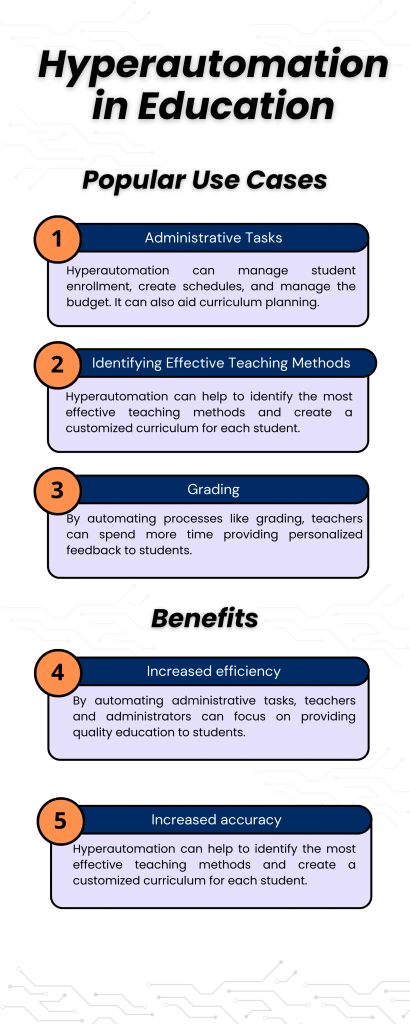Hyperautomation in Education: Use Cases, Benefits, and Solutions


The successful incorporation of technology into education has shown the world just how powerful a tool it can be for transforming learning; tech has helped affirm and advance relationships between educators and students and reinvented conventional approaches to learning and collaboration.
In this era of advanced technology, automation has already revolutionized various industries, including healthcare, finance, and manufacturing. The education sector is no exception to this trend.
While hyperautomation and its associated technologies have many potential applications within higher education to improve modernization strategies, specialists believe that educational institutions that adopt hyperautomation may experience immediate benefits in addressing everyday challenges such as:
Related article: A Practical Guide to Implementing Hyperautomation Into Your Enterprise
Hyperautomation, as highlighted in our comprehensive guide, is essentially technology that can automate many processes, including administrative tasks, curriculum planning, and learning assessments. The technology combines artificial intelligence (AI), machine learning (ML), and robotic process automation (RPA) to create a smarter, more efficient, and more productive system.
The pain points that the education sector faces, as highlighted above, can be addressed with hyper-automated integrations. For example, educational institutions need to manage large amounts of data on student enrollment, academic performance, and teacher evaluations.
A simple use case of hyperautomation here can automate these processes and reduce the burden on administrative staff, enabling them to focus on more valuable and pressing tasks. In addition, hyperautomation can improve the quality of education by providing personalized learning experiences for each student!
By using AI and ML algorithms, hyperautomation can identify the learning style of each student and create a customized learning experience that meets their individual needs. Furthermore, hyperautomation can help to reduce costs by automating repetitive tasks, such as grading assignments, scheduling classes, and sending reminders to students.
One of the most promising use cases is the automation of administrative tasks. For example, hyperautomation can be used to manage student enrollment, create schedules, and manage the budget. Another use case is the automation of curriculum planning.
Hyperautomation can help to identify the most effective teaching methods and create a customized curriculum for each student.
Hyperautomation can be used to automate assessments, such as grading assignments and exams. By automating these processes, teachers can spend more time providing personalized feedback to students.

Yes! By adopting use cases like the above, here’s how hyperautomation can be of benefit to the education sector–
One of the primary benefits is increased efficiency. By automating administrative tasks, teachers and administrators can focus on providing quality education to students and can provide personalized learning experiences for each student.
This handy piece of technology can help to reduce costs by automating repetitive tasks, such as grading assignments and scheduling classes. By reducing the workload of administrative staff, educational institutions can save money and improve productivity.
Another benefit of hyperautomation is increased accuracy. By using AI and ML algorithms, hyperautomation can identify the learning style of each student and create a customized learning experience that meets their individual needs. This, in turn, provides enough data for the most effective teaching methods to be identified. Hyperautomation integrations can create a customized curriculum for each student, improving their academic performance!
Hyperautomation technology can truly revolutionize the education sector! The use cases of hyperautomation in education are numerous, and the benefits of hyperautomation are significant. As educational institutions face challenges in managing large amounts of data, providing quality education, and reducing costs, hyperautomation technology will become an increasingly important tool to help address these challenges.
Integrating Autonom8 into your workflow can give your faculty and staff the firepower they need in this back-to-school season. Here are a few of the many use cases you could adopt with the A8 suite for your institution –
Elevate the campus experience and look at the service offerings on the table in Autonom8’s Hyperautomation platform for education video here. Sign up for Autonom8’s hyperautomation platform for education today to see how we can make your educational institution soar.
Hyperautomation is a technology that combines artificial intelligence, machine learning, and robotic process automation to automate a wide range of processes, including administrative tasks, curriculum planning, and learning assessments.
Hyperautomation can benefit the education sector by automating administrative tasks, providing personalized learning experiences for each student, reducing costs, and improving the quality of education.
Some use cases of hyperautomation in education include automating administrative tasks, curriculum planning, and assessments such as grading assignments and exams.
Hyperautomation technology can identify the learning style of each student using AI and ML algorithms and create a customized learning experience that meets their individual needs.
Hyperautomation technology can reduce costs by automating repetitive tasks, such as grading assignments and scheduling classes, and reducing the workload of administrative staff.
Some benefits of hyperautomation in the education sector include increased efficiency, improved accuracy, personalized learning experiences, and cost savings.
Fill in your details and our executive will get in touch within 48 hours
Fill in your details and our executive will get in touch within 48 hours